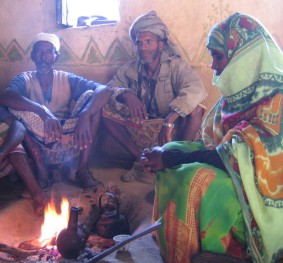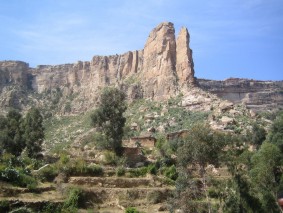|
Birdwatching in Eritrea Eritrea Information |
||||||||||||||||||||||||||||||||||||||
| Home |
Where is Eritrea? Eritrea is a small country in North East Africa, located on the Red Sea coast at the northern edge of the Great Rift Valley between Ethiopia and Sudan. It formally declared its independence in 1993, making it one of the youngest countries in Africa. It has a population of approximately 4 million people living in a land of 125,000 square kilometres.
People, Culture and Languages As well as its formidable birdwatching, Eritrea is a country of great natural beauty and very friendly people. Many first time visitors are surprised to learn that Eritrea is one of the safest countries in Africa. Eritreans are renowned for their hospitality. Don't be surprised if you get invited back to people's houses for coffee ceremonies, or if people chat to you in the streets. There is very little begging, except in the capital, Asmara, and the vast majority of people who are likely to come up to you are genuinely interested in who you are and where you come from.
There are 9 official ethnic groups in Eritrea, each with their own language: Tigrinya, Tigre, Saho, Afar, Bilen, Hedareb, Kunama, Nara, Rashaida. Generally speaking, Tigrinya is the lingua franca of the capital and interaction between different ethnic groups, although in the north and west Arabic often becomes the lingua franca. English is widely spoken, as it is the language of instruction from junior school to university, so all younger Eritreans speak some English. Italian is also spoken by some of the older people, generally over 55.
The Tigrinya are Christians, following the Eritrean Orthadox Church. Most of the other ethnic groups are Muslim. As the Tigrinya are the most numerous ethnic group, this means a 50-50 divide between the two religions.
The Tigrinya written language uses a syllabic character system called Ge'ez, which derives from the ancient Orthadox church language of Eritrea and Ethiopia. Most letters represent a consonant and a vowel. A few represent just vowels. Other languages have only been transcribed into written form over the last 20 or so years, and usually use the Latin alphabet (e.g. Saho).
A few words of Tigrinya
Geography and Climate Despite being a small country, Eritrea has a lot of variety in its geography, creating a wide range of biospheres in a small country. This is chiefly thanks to the Abyssinian highlands which rise in Eritrea to a height of over 3000m, and divide the country into 3 basic climatic zones. To the east of the highlands are the sweltering coastal plains - hot in winter and very hot in summer! Temperatures in Massawa and Foro stay at over 40oC during the summer months, even at night. And further south in the Danakil Depression they rise even higher, reputedly over 50oC! This coastal plain has plenty of plant and bird life, due to the rivers and groundwater that pass from the highlands to the sea. The rainy season here tends to be from December to March.
To the west of the central highlands, in the Zoba (province) of Gash Barka, the land falls gently towards Sudan, covered by acacia forest. As well as supporting many of the bird species typically associated with East African savannah, there is still some large game wildlife here (albeit much diminished compared to 100 years ago), including several species of gazelle, leopard, spotted and striped hyena, a small population of elephant, and occasional reports of lion. Gash Barka has warm winters and very hot summers (over 40oC). The two rivers Gash and Barka cut through this plain, although they dry up during the dry season, and often flood during the late summer rains in July and August.
Eritrea has 1000km of Red Sea coastline, stretching from the Sudanese border in the north to the Djibouti border in the south. Due to the lack of tourism and industrial development, the coast remains probably the most pristine on the Red Sea, and prized by divers as a result. Most notable is the archipelago of islands known collectively as the Dahlak Islands. The majority of the islands are unpopulated, and there is little industrial-scale fishing, so the coral reefs bloom with fish, turtle and sea mammal species that are rare in other parts of the Red Sea. These include Dugong, Whale Shark, Manta Rays, plentiful dolphins (I saw 4 species in one 3-day visit), and 4 species of turtle, many of which nest on the islands. Smaller islands have nesting seabird colonies, and larger islands have similar birdlife to the coastal plains. The central coastal area around the Bay of Zula has extensive mangrove forest, home to the White-collared Kingfisher, which, within Africa, is only found in Eritrea.
Eritrea is split into 6 provinces, called zobas. These are to the east, Debubawi Keyih Bahri (Southern Red Sea) and Seminawi Keyih Bahri (Northern Red Sea), in the highlands, from south to north, Debub (South), Ma'akel (Central,where the capital Asmara is located) and Anseba around the city of Keren. Then to the west is the extensive zoba of Gash-Barka (named after the two rivers that bisect it from east to west). |
|||||||||||||||||||||||||||||||||||||
| Eritrea Information | ||||||||||||||||||||||||||||||||||||||
| Abyssinian Endemics | ||||||||||||||||||||||||||||||||||||||
| Bird Checklist for Eritrea | ||||||||||||||||||||||||||||||||||||||
| Travel & Accommodation | ||||||||||||||||||||||||||||||||||||||
| In Italiano | ||||||||||||||||||||||||||||||||||||||
| Photos | ||||||||||||||||||||||||||||||||||||||
| Other Wildlife | ||||||||||||||||||||||||||||||||||||||
| Asmara Birdwatching | ||||||||||||||||||||||||||||||||||||||
| Filfil Birdwatching | ||||||||||||||||||||||||||||||||||||||
| Adi Keih Birdwatching | ||||||||||||||||||||||||||||||||||||||
| Massawa Birdwatching | ||||||||||||||||||||||||||||||||||||||
| Dahlak Islands Birdwatching | ||||||||||||||||||||||||||||||||||||||
| Elabered / Keren Birdwatching | ||||||||||||||||||||||||||||||||||||||
| Gash Barka Birdwatching | ||||||||||||||||||||||||||||||||||||||
| Contacts and Services | ||||||||||||||||||||||||||||||||||||||
| Links | ||||||||||||||||||||||||||||||||||||||
|
|
||||||||||||||||||||||||||||||||||||||
|
|
||||||||||||||||||||||||||||||||||||||

 The
central highlands vary from flat fertile plateaus (around Asmara) to
rugged mountains (around Adi Keih and Senafe). This is the highly
populated part of the country with lots of agriculture, so less native
forest remains, but there is still a lot of bird life. Certain
areas, for example the Elabored Agricultural Estate, which is irrigated
year-round, have become havens for birds during the dry season (generally
October to May). Around Asmara, the reservoirs also attract a
concentration of birds, and plenty of acacia forest remains in less
densely-populated areas. Where the mountains meet the humid coastal
plains, a lot of precipitation falls, allowing rainforest to flourish in a
few areas, most notably the Filfil Rainforest. The climate in the
highlands is very consistent and agreeable, ranging between 18-25oC
all year round. It can feel very hot in the sun up here, and
surprisingly cool in the shade. Night time temperatures can fall as
low as zero in the winter, and cloud fog is common in parts close to the
eastern edge of the escarpment (for example at Dekemhare).
The
central highlands vary from flat fertile plateaus (around Asmara) to
rugged mountains (around Adi Keih and Senafe). This is the highly
populated part of the country with lots of agriculture, so less native
forest remains, but there is still a lot of bird life. Certain
areas, for example the Elabored Agricultural Estate, which is irrigated
year-round, have become havens for birds during the dry season (generally
October to May). Around Asmara, the reservoirs also attract a
concentration of birds, and plenty of acacia forest remains in less
densely-populated areas. Where the mountains meet the humid coastal
plains, a lot of precipitation falls, allowing rainforest to flourish in a
few areas, most notably the Filfil Rainforest. The climate in the
highlands is very consistent and agreeable, ranging between 18-25oC
all year round. It can feel very hot in the sun up here, and
surprisingly cool in the shade. Night time temperatures can fall as
low as zero in the winter, and cloud fog is common in parts close to the
eastern edge of the escarpment (for example at Dekemhare).